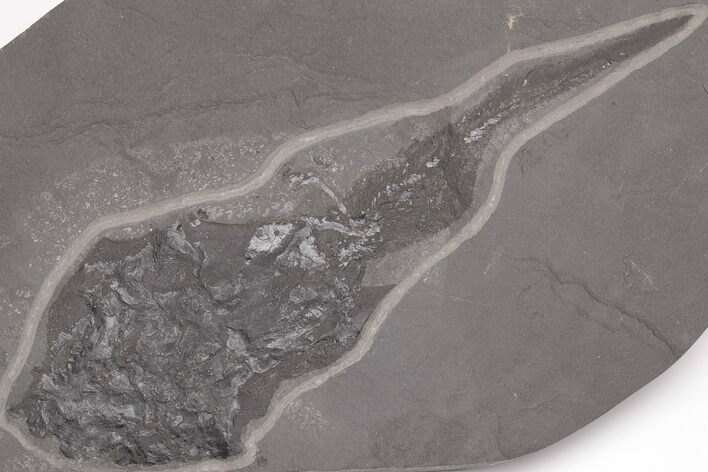13" Devonian Armored Fish (Coccosteus) Fossil - Scotland
This is an extremely well-preserved 400 million year old fossil worthy of any collection. It's a nearly complete armored fish (Coccosteus cuspidatus) from the Cruaday Hill Quarry of the Old Red Sandstone in Scotland. It's 13 inches long on a 16.5 x 10.5" slab of rock with little to no restoration or repair. The preservation is excellent and allows the observer to understand the thickness of the fish's armor plating.
This specimen is accompanied by an acrylic and metal display stand.
This specimen is accompanied by an acrylic and metal display stand.
About Coccosteus
Coccosteus was an arthrodire, belonging to an extinct order of armored, jawed fishes (placoderms) found in Devonian (416 million to 359 million years ago) freshwater and marine deposits. The earliest arthrodires, such as Arctolepis, were fully armored fishes with flattened bodies. They had hollow, backward-curved shoulder spines that may have bene used to anchor themselves or to move about on the bottom of their respective underwater environments.
Later arthrodires such as this Coccosteus were less heavily armored, and the bony head and body shields were connected by a joint on each side for free head movement. They were predators with bony jaws optimized for incredible crushing bite force. The upper jaw was lined with two toothplates per side, whereas the lower jaw had one on each side. The back of the body and the tail were unarmored, and its head shield was reduced, an evolutionary requirement of increasingly predatory habits. Coincidentally, the shoulder spines were also shortened.
The famous “terror of the Devonian seas“(Dunkleosteus) was very similar in appearance to Coccosteus but grew in excess of a whopping 30 feet. By comparison, no Coccosteus has ever been recorded over 2 feet long.
Coccosteus was an arthrodire, belonging to an extinct order of armored, jawed fishes (placoderms) found in Devonian (416 million to 359 million years ago) freshwater and marine deposits. The earliest arthrodires, such as Arctolepis, were fully armored fishes with flattened bodies. They had hollow, backward-curved shoulder spines that may have bene used to anchor themselves or to move about on the bottom of their respective underwater environments.
Later arthrodires such as this Coccosteus were less heavily armored, and the bony head and body shields were connected by a joint on each side for free head movement. They were predators with bony jaws optimized for incredible crushing bite force. The upper jaw was lined with two toothplates per side, whereas the lower jaw had one on each side. The back of the body and the tail were unarmored, and its head shield was reduced, an evolutionary requirement of increasingly predatory habits. Coincidentally, the shoulder spines were also shortened.
The famous “terror of the Devonian seas“(Dunkleosteus) was very similar in appearance to Coccosteus but grew in excess of a whopping 30 feet. By comparison, no Coccosteus has ever been recorded over 2 feet long.
$1,950 $1,500
SPECIES
Coccosteus cuspidatus
AGE
LOCATION
Cruaday Hill Quarry, Orkney Isles, Scotland
FORMATION
Old Red Sandstone
SIZE
Fish: 13" long, Entire specimen: 16.5 x 10.5”
CATEGORY
SUB CATEGORY
ITEM
#206851
We guarantee the authenticity of all of our specimens.
 Reviews
Reviews












